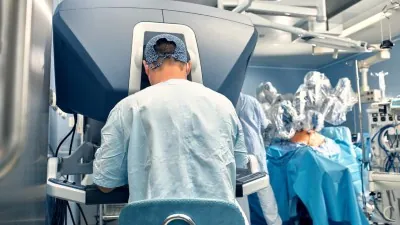
Breakthrough in Robotic Prostatectomy: NeuroSAFE Technique Shows Promising Functional Outcomes
2025-03-28
Author: Siti
Introduction
A recent phase 3 study published in The Lancet Oncology reveals that employing the NeuroSAFE technique during robot-assisted radical prostatectomy (RARP) significantly enhances functional outcomes for patients one year post-surgery, compared to traditional nerve-sparing preparation methods. This pioneering approach assesses real-time intraoperative frozen sections of the neurovascular bundle-adjacent prostate margin, allowing for precise identification of positive surgical margins during nerve-sparing procedures.
Study Overview
Lead researcher Greg Shaw and his team from University College London Hospitals NHS Foundation Trust conducted the study involving men with nonmetastatic prostate cancer who underwent RARP between 2019 and 2022 across five hospitals in the UK. All participants had retained good erectile function prior to surgery, scoring at least 22 on the International Index of Erectile Function (IIEF-5).
Findings
After an average follow-up of approximately 12 months, the findings were compelling. Men utilizing the NeuroSAFE technique reported a superior average IIEF-5 score of 12.7, in stark contrast to the 9.7 average from those undergoing standard RARP. Additionally, scores from the erectile function domain of the IIEF-6 measure were markedly higher in the NeuroSAFE group (15.3) compared to the control group (11.5).
Procedure Duration and Efficacy
While the NeuroSAFE technique took about 43 minutes longer to perform on average—requiring 174.4 minutes compared to 131.4 minutes for standard RARP—the results underscore its potential advantages. Surgeons had a greater likelihood of achieving bilateral nerve-sparing with NeuroSAFE (82% vs. 56%) and a lower rate of unsuccessful nerve-sparing (1% vs. 6%).
Bilateral Nerve-Sparing Outcomes
Interestingly, even among the 68% of participants for whom bilateral nerve-sparing was not advised preoperatively, the NeuroSAFE technique still yielded significantly higher IIEF-5 scores compared to standard procedures, though no difference in the International Consultation on Incontinence Questionnaire (ICIQ) scores was observed between the two groups at 12 months.
Safety Profile
The safety profile of both techniques appeared similar, with comparable adverse events recorded. Researchers noted no deaths related to prostate cancer or surgery in either group.
Oncological Outcomes
When examining oncological outcomes, persistence of prostate-specific antigen levels was slightly higher in the NeuroSAFE cohort (4% vs. 3%), but the overall rates of biochemical recurrence and the need for adjuvant therapy were generally not significantly different between the two groups. Notably, 86% of patients treated with NeuroSAFE displayed no signs of recurrence or required additional treatment, compared to 93% of control patients.
Conclusion and Future Implications
Despite the encouraging results, the authors highlight that their trial was not adequately powered to assess differences in oncological outcomes. Nevertheless, supporting evidence from previous retrospective studies does not indicate any long-term oncological disadvantages associated with the NeuroSAFE technique.
The researchers conclude that their findings validate the efficacy of NeuroSAFE in enhancing functional outcomes post-RARP for patients with strong preoperative erectile and urinary function and advocate for guideline updates to incorporate this valuable technique in surgical practices.
As the medical community awaits further long-term results from this trial, it remains imperative for patients to receive thorough counseling regarding the functional benefits of NeuroSAFE and its ambiguous implications for treatment requirements in the future.
This groundbreaking research signifies a significant leap forward in the field of prostate surgery, offering hope that innovative techniques like NeuroSAFE may revolutionize patient outcomes in robotic prostatectomies. Stay tuned for more updates as additional research unfolds!



 Brasil (PT)
Brasil (PT)
 Canada (EN)
Canada (EN)
 Chile (ES)
Chile (ES)
 Česko (CS)
Česko (CS)
 대한민국 (KO)
대한민국 (KO)
 España (ES)
España (ES)
 France (FR)
France (FR)
 Hong Kong (EN)
Hong Kong (EN)
 Italia (IT)
Italia (IT)
 日本 (JA)
日本 (JA)
 Magyarország (HU)
Magyarország (HU)
 Norge (NO)
Norge (NO)
 Polska (PL)
Polska (PL)
 Schweiz (DE)
Schweiz (DE)
 Singapore (EN)
Singapore (EN)
 Sverige (SV)
Sverige (SV)
 Suomi (FI)
Suomi (FI)
 Türkiye (TR)
Türkiye (TR)
 الإمارات العربية المتحدة (AR)
الإمارات العربية المتحدة (AR)